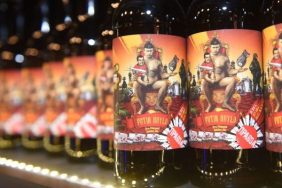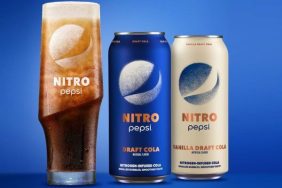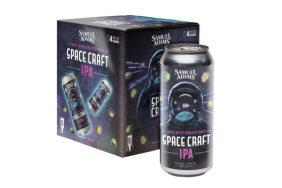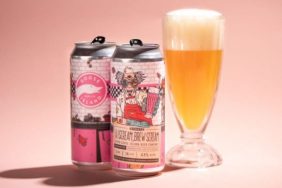Recently, Samuel Adams released a line of nitro beers. If you didn’t guess it already, “Nitro” is short for nitrogen. But, don’t be afraid. These beers don’t contain liquid nitrogen, and you shouldn’t have any fear that they will freeze your stomach like the unlucky bar patron in England last fall. “All beer has a significant amount of carbon dioxide when it’s carbonated as part of the brewing process, but nitro beers use a combination of both nitrogen and carbon dioxide,” says Jim Koch, Samuel Adams founder and brewer.
Also: More Red, White, and Brewed
According to Koch, nitrogen is pretty much insoluble in beer. This creates a lot of bubbles, but not a lot of carbonation. The tiny bubbles make the beer extremely rich and almost creamy in mouth feel. “When nitro beers are poured, they create a beautiful cascade down the side of the glass, along with a thick, creamy, frothy head.” You’ve probably already seen this if you have purchased a can of Guinness in the last decade. The famous Irish stout has been using nitro technology for years. “On the flip side, beers that are carbonated generally have larger bubbles and a sharper tongue and texture.” Think of it like water vs. sparkling water. “Both are water, but the taste experience is radically different as a result of the gas mixture,” says Koch.
How Does it Work?
If you go to a bar that has nitro beers on draft, they need a fairly elaborate system to make it work. When a nitro beer is poured on tap, the faucet needs to contain a piece of equipment referred to as a “sparkler”. This internal plate is full of small holes. “When the beer is forced through the holes at high pressure, it produces tiny bubbles that create the trademark nitro cascade.” Since the beer needs to be under a lot of pressure to create the proper consistency, it must be forced out of the draft using a nitrogen gas blend.
For Samuel Adams Nitro cans, they are using a hollow, cylindrical widget to create the nitro cascade that customers expect. “When the can is popped, the widget releases the nitrogen gas into the beer under intense pressure.” Koch suggests that once you have opened your can, you should immediately pour the beer straight down the center of your pint glass to experience the maximum magic of the nitro cascade. Don’t be afraid to do this. Since it’s not like a normal, heavily carbonated beer, it won’t overflow or have a ridiculously frothy head. You’ll just see a magnificent cascade of carbonation.
Koch says the best part of being a brewer is having the opportunity to experiment and to stretch the boundaries of brewing. And he is well-known for doing this over the years. Samuel Adams is responsible for a variety of unique beers, including Rebel Grapefruit IPA, American Kriek and the 30% ABV Utopias.
When people think about the ingredients in beer, they typically think about the four traditional ingredients – hops, yeast, water and malt. “But we found that nitrogen can be the unexpected fifth ingredient, and can completely change the flavor profile of a beer.”
Koch began experimenting with nitro technology in the mid-90s. Back then, he brewed a Boston Cream Ale using the technique. “Over the past three years, we’ve experimented with a variety of styles and recipes. We saw that most people associated nitro solely with stouts, so we wanted to have some fun and nitrogenate a variety of styles.”
“Nitrogen completely transforms the flavor profile of a beer,” says Koch, who experimented with more than fifty different beer styles and varieties before he found the right beers. After all the research he realized that you definitely can’t make any beer style into a nitro beer. Some just don’t work. “We needed to develop recipes where nitrogen was the unexpected fifth ingredient and really brought out the desired flavor profile of the brew.” He estimates that on top of brewing more than fifty beer styles, they also worked with over one-hundred different recipes to ultimately create these three unique beers. He believes that the first three Samuel Adams Nitro Series beers are the perfect styles for the technology.
Adding nitrogen to beer results in the formation of millions of small bubbles. This gives nitro beers their rich, creamy texture and smooth mouth feel. “When poured, nitro beers create a beautiful cascade down the side of the glass, which settles into a thick, creamy, frothy head,” says Koch. “The flavors of nitro beers are also generally softer than in non-nitro beers due to the lack of carbonation.
The first three beers from the Nitro Project are Nitro White Ale, Nitro Coffee Stout, and Nitro IPA.
Nitro White Ale
This rich, very smooth, medium bodied white ale is made with orange peel, Grains of Paradise (one of Koch’s favorites) and coriander. “All of which contribute to the beer’s subtle citrus and peppery character,” says Koch.
Nitro Coffee Stout
Made using Indonesian Sumatran Mandheling coffee beans as well as Indiana Monsoon Malabar coffee beans, this rich, coffee stout is a combination of roasted coffee sweetness and rich malt. “These varieties add a deep roasted dimension to the brew, and we chose them because they lacked the acidity that coffee beans often exhibit,” says Koch.
Nitro IPA
This IPA was made with six different hop varieties – Amarillo, Centennial, Galaxy, Polaris, Simcoe, and Zeus. The differing hops give the beer a combination of zest citrus, pine needles and aromatic floral. “Because the lack of carbonation in Nitro reduces perceived bitterness, we had to amp up Nitro IPA to 100 IBUs. But it drinks much more like a beer in the 50 IBU range, with a nice pronounced hop flavor,” says Koch.
Koch loves hearing feedback, so he encourages drinkers to try these beers for themselves and experience the art of the nitro pour first-hand. “All three of our Nitro Project beers are available in 4-packs of 15 oz. cans and our Nitro White Ale is also available on draft.”









